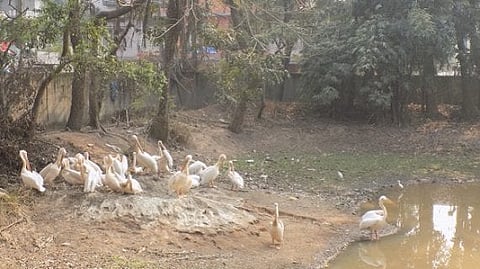
- Home
- Live Blog
- Breaking News
- Top Headlines
- Cities
- NE News
- Sentinel Media
- Sports
- Education
- Jobs

GUWAHATI: Despite rapid urbanization, Guwahati is still a safe home for at least 26 species of amphibians, 57 species of reptiles, 214 species of birds, and 36 species of mammals, a rare phenomenon in an Indian city.
During a six-year-long study conducted by Jayaditya Purkayastha altogether 26 species of amphibians representing seven families were encountered. Among these, a single species is vulnerable, four species were deemed data deficient and 21 species were of least concern (according to IUCN rules).
On other hand a total of 53 species of reptiles representing 11 families were encountered from the city during the study conducted in between 2011 and 2016. Among these, a single species is extinct in the wild (black soft-shell turtle), two species are endangered, five are vulnerable, 31 species are not evaluated and 14 species are of least concern.
Jayaditya Purkayastha who also heads Help Earth, an NGO told The Sentinel on Saturday that even though there is still hope for survival of wildlife in Guwahati in the face of onslaught of rapid urbanization, the government has to go for massive afforestation drive in and around the city.
“We have to create artificial living space, more specifically for birds, by installing nesting boxes. It will not only help the birds to have safe shelter but also help generate interest among the masses regarding the conservation of urban biodiversity,” Purkayastha said.
Expressing grave concern that the conservation status of about 60 per cent of the reptilian fauna recorded from the city has not yet been evaluated, Purkayastha said the turtles mentioned in the study said majority of such reptile are found in temple ponds of Ugratara and Kamakhya. He said unorganized turtle trade for flesh and as pets continues within the city.
Purkayastha said though Guwahati has lost a big chunk of its biodiversity, it is difficult to specify the loss because they did not have data to compare with the current status. “The dynamics of biodiversity change much faster in an urban landscape. The anthropogenic factor plays a vital role in altering the ecosystem in urban areas where the rate of loss of biodiversity and habitat destruction is high. The assessment of biodiversity in urban areas becomes imperative to formulate long-term conservation strategies,” Purkayastha said.
Save Guwahati Build Guwahati, a leading NGO has appreciated Purkayastha’s study and urged the State Government to act on recommendations of the study to maintain the rich biodiversity of Guwahati for future generation.
Also Read: Guwahati News